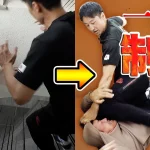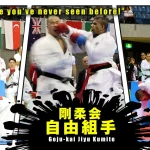Leandro Diaz Napolitano: A gentleman from Brazil
Despite being born with a disability in his right leg, Brazilian diplomatic officer Leandro Diaz Napolitano entered the world of martial arts at a very early age and today he is still practicing aikido, kyudo and Tenshinsho-den Katori Shinto-ryu. In this interview, he talks about his practice, his understanding of martial arts and his thoughts on culturally connecting his home country and Japan.
Interview and Text by Grigoris Miliaresis

Katori Shinto-ryu bojutsu
A couple of years back, while arranging the next monthly drink, eat and chat get-together of our informal group of martial artists living in and around Tokyo, Tenshinsho-den Katori Shinto-ryu, Chikubujima-ryu bojutsu practitioner, researcher and good friend Michael Reihnardt, said “I asked my friend Leo from the Sugino Dojo to join us: he’s a Brazilian diplomatic officer and quite an interesting guy”. Saying that Leo aka Leandro Diaz Napolitano aka Head of the Education and Sports Section at the Embassy of Brazil in Tokyo is “quite an interesting guy” is an understatement. Besides studying Tenshinsho-den Katori Shinto-ryu, the 40 year-old foreign service officer living in Japan since 2015 is a 4th dan in aikido and kyudo, studies Heki-ryu Inzai-ha classical archery at the Urakami Dojo, has also delved into ikebana, traditional Japanese washoku cuisine, shamisen and shakuhachi and since last year he’s also a member of the Nihon Budo Gakkai. And he does all that, balancing on one leg –literally, since because of a congenital malformation he wears a prosthetic leg from his right knee downwards.
What follows is Mr. Leandro Diaz Napolitano in his own words. After having met him several times and having discussed a variety of topics –from martial arts to Japanese culture, to world events to his ongoing work towards social diversity and the empowerment, inclusion and accessibility of people with disabilities – I believe more than before that Michael Reinhardt had it exactly right!
Starting in Brazil, continuing in Japan: aikido, kyudo, koryu
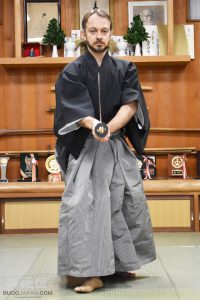
Katori Shinto-ryu iaijutsu
Walk us through your involvement with Japanese martial arts. You first started with aikido, correct? Where and how?
Actually I started with Kyokushinkai karate when I was 10 years old and practiced for about two years. Living in Atibaia, a small town in Sao Paulo’s countryside known for its unique nature, I was also involved in all kinds of outdoor activities as well -hiking, mountain biking, etc. Despite my physical condition, my parents always treated me in a natural and active way to help me become self-reliant: if I wanted something, they wouldn’t serve me but rather they would make me go for it and encourage me to do it. Aikido came later, when I was in my fourth year of law school, as a stress-relief activity, while studying for the very hard Brazilian Foreign Service entrance examination.
And next was kyudo?
As a matter of fact, kyudo was my first interest after having read Eugen Herrigel’s “Zen in the Art of Archery” but at that time it wasn’t available in Brazil. It was first introduced in 2008 and in 2011 I found in in Brasilia the (then) recently founded Kyudo Kai DF –and enrolled.
So you pass your exams and enter the Ministry of Foreign Affairs. But you didn’t come to Japan immediately after that, right?
No: I entered the Ministry of Foreign Affairs in 2002 and between then and my post to Japan in 2015, I was serving at the HQ’s Trade and Investment Promotion Department, supporting Brazil’s international trade. During the breaks in my working trips abroad tight schedules’ I always tried to connect with local aikido dojo, which gave me the chance to make friends all over the world. By that time I understood how close diplomacy’s essence and O-Sensei Ueshiba teachings were: both were meant to build bridges.
After coming to Japan you continue aikido and kyudo and at some point also start Katori Shinto-ryu at the Sugino dojo. Why that particular school?
That was because of our common friend Michael Reinhardt! I had already been practicing martial arts for 14 years, had read some books about classical arts (Draeger, Skoss, Amdur, etc.) and so on October 2015 I went to see them live in the demonstration at Kashima Jingu. This is where I met Michael and he kindly arranged a visit to his dojo, the Sugino Dojo in Kawasaki. I immediately fell in love with what I saw so I enrolled and have been practicing since.
Lessons learned and interweaved
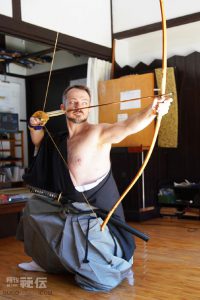
Kyudo (photograph: Nakamura Masaki)
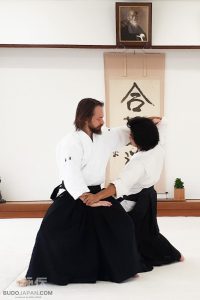
Aikido (Uke: Tetsu Wada)
This aikido, kyudo and Tenshinsho-den Katori Shinto-ryu combination is rather unusual combination. Can you share some of the insights you have gained from practicing these arts?
Well, aikido is obviously about movement and dynamism and this is what has given me the foundation to walk in other paths; it has taught me how to adapt, how to change quickly my center of gravity, how to regain my balance and how to fall and get up. Kyudo is more static but has more ups and downs -with every shot you are resetting and restarting and you only have one chance to get it right. These are things that aren’t visible from outside but there’s a lot going on inside both physically and emotionally; also, there is a whole range of adaptations and considerations you have to deal with when shooting in a group as is often the case. For me, koryu (both Katori Shinto-ryu and Heki-ryu) are a way to connect the present with the past: you go back in history and you understand where the modern arts come from and why they are the way they are, you get to explore some of the subtleties still found in modern arts and also the practical aspect of these arts.
When you practice different arts you can always notice similarities or common elements and take things from one art to the other. For instance, one similarity between aikido and kyudo is in absorbing and releasing force –in the case of kyudo, this manifests in the draw of the bow and the shooting of the arrow at the moment of maximum expansion while in the throwing techniques of aikido, the force comes from outside, from the opponent and their attack which you have to absorb and expand it in a circular movement projecting your partner thus neutralizing their energy.
Aikido and Katori Shinto-ryu also have common elements and you start noticing them after you become familiar enough with the techniques that they make sense to you. One such element that I learned in aikido and rediscovered in Katori Shinto-ryu is the concept of “nebari”; this translates as “stickiness” (as in Japanese rice) but it also means the connection with your partner when executing techniques. In aikido this connection is often described with the word “musubi” which is also the Japanese word used for “knot” or for “join” and starts before the attack, when you sense an invisible contact established with the intention directed to you, continues when you receive the attack and stays there until the final moment. Keeping this connection is fundamental in aikido and so is in Katori Shinto-ryu where this connection is always present but between your weapon and your opponent’s.
One concept that is common in all three arts -in all arts basically- but that was made much more clear to me through kyudo where it’s one of the eight steps of shaho, the shooting form, was the concept of zanshin, the continuing, never-ending awareness before, during and after any encounter that extends towards all directions. Developing this sense and keeping it always present and always fine-tuned, is one step towards not just “doing” budo but actually “becoming” budo in your body, your mind and your spirit and this is something that can give you readiness and confidence.
Physical handicaps, challenges and solutions

Katori Shinto-ryu naginata
You have a disability. Could you tell us a little more about what it is?
I was born with a congenital malformation of the right leg which is similar to an amputation bellow the knee. This means that I need to wear a prosthetic leg with a hard shin socket and a rubber-covered foot part which needs to be replaced about once a year because it gets worn from use, especially in budo (aikido’s suwari waza techniques or Katori Shinto-ryu’s iai techniques) and replacing it is important because when it’s worn it affects my balance and movements. Whenever I have the chance, I also like to take it out so I can experience the techniques without it.
For many people a disability becomes a barrier, especially when it comes to physical activities. It hasn’t been so in your case -how did you manage that?
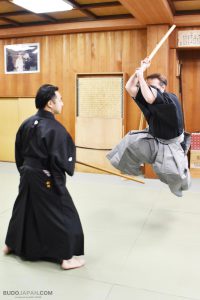
Katori Shinto-ryu kenjutsu
This had a lot to do with the way I was brought up. I usually say that my parents were my first sensei in the sense that they brought me up in a way that didn’t make me think as if I was missing anything. Their physical and psychological support combined with lots of hard work allowed me to start walking when I was one year-old like any other child and this goes until now, helping me to never see my leg as an impediment for what I wanted to do –from outdoor activities, to scuba diving, doing martial arts or going to law school, I could always see myself doing what I wanted so I could do it.
And martial arts?
Martial arts have empowered me and I believe they can empower any other person with a disability. While empowerment deals with becoming confident in order to walk your own path, inclusion and accessibility are concepts related to giving access and granting the same opportunities to everyone in all dimensions of life. In our case, for example, a dojo might not have an elevator and someone with a disability might literally need to crawl up the stairs to join a class. That person has the power to do it because of their love and devotion to the martial arts but wouldn’t it be better if that dojo was fully accessible allowing more people to be included in practice and giving them the same opportunity to self-development?
Changing the world for accessibility and inclusion
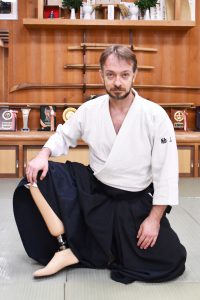
Leandro Diaz Napolitano and his artificial limb.
People with disabilities becoming 100% equal in our societies is a big issue involving change both in policies and in people’s attitudes but if you had to point out the pillars of that change what would they be?
Again, it’s not about being equal, because everyone is singular in essence and has different conditions. It’s about increasing opportunities and allowing everyone to dream beyond the psychological trap that comes from the disability while living in a typical society. Lately with the 2006 UN Convention for the Rights of People with Disabilities there has been a great improvement towards humanizing the way people with disabilities are treated by enforcing the right to human dignity. Besides covering a broad range of specific needs and offering services to citizens with disabilities, there are affirmative actions that contribute to improve things towards people who had to struggle with challenges a typical society doesn’t have to face during their different stages of human development, for example, creating openings for job positions (in both the private and public sector) for them.
Also important is listening to people with any kind of disability so they themselves can point out what are the most effective ways to allow them to share common spaces; for instance living in Japan I have found that sometimes the concepts of inclusion and accessibility seem to be somehow dissociated: i.e. once at a famous tourist spot, even though there were specific lanes for people with disabilities they wanted me to show my Japanese access certificate (which I couldn’t get due to the nature of my visa). In a world where a person is respected and valued for their own sake, none of that would have to be requested or needed.
How does your disability influence your practice? You mentioned before that you sometimes practice aikido without the prosthetic leg; what other adjustments you have to do?
Well, in aikido and kyudo, my prosthetic leg hinders some movements -for example in kyudo I prefer to perform standing since I cannot perform a proper seiza or kiza as per the Kyudo Federation’s requirements. In aikido, because my leg doesn’t have ankle movement, ukemi on the right side was very challenging in the beginning and so were all kuzushi techniques – which are slowly improving along the years thanks to the seated techniques. Generally speaking and despite any adjustments I need to do, I try to preserve the core of the techniques; for example, in Katori Shinto-ryu, it is important to keep the toes pointing outwards which in the beginning was almost impossible for me because of my prosthetic leg. Nevertheless, I kept practicing keeping in mind the techniques’ essence and that the adjustment I was doing was temporary and eventually, my body adapted and now I can move with my toes pointing outwards, as they should. Now my main struggle is on improving the proper hanmi posture for long weapons so the whole thing is a process requiring patience and research from both the student and the teacher, so it is important that there is a will for this to happen. It’s also a mental adaptation: often martial artists aren’t used seeing a person with a disability at their dojo. One time at the Aikikai Hombu, the teacher saw my prosthetic leg leaning on the wall and not knowing it was mine, he was concerned that someone from a previous class had forgotten it there!
A cultural bridge between Japan and Brazil
You are in Japan to serve your country so at some point you will leave, either to return to Brazil or to go somewhere else -this is the nature of diplomatic work. How do you intent to continue your relationship with Japanese culture outside Japan?
Before coming to Japan, budo was just a physical activity -an important physical activity that got me through a lot but nonetheless, something I did. After coming here and being completely immersed in it and the culture that created it, I now feel budo is my lifelong pursuit, my ikigai, that will be with me wherever I go. In that sense, my relationship with Japan will remain strong and my practice will continue anywhere I am -besides, the deep bonds I have created here, instilled in me the necessity to return to visit my teachers and friends and deepen my knowledge.
I said before that part of my work is building bridges promoting educational exchange between people; this is one of the most important ways to create a cooperative environment instead of a competitive one. At the Embassy of Brazil, being in charge of Education and Sports Cooperation matters I have experienced the joy of creating bridges between Brazil and Japan; I particularly enjoy when Japanese students visit the Embassy and besides telling them about Brazil, we offer cultural workshops on, say, capoeira, Brazilian music or Brazilian Jiu-Jitsu. I do the same with Brazilian children (Brazilians are Japan’s fifth largest community) visiting us: I introduce them to Japanese traditional arts -budo, sado or shodo- offering them an experience to help raise their awareness and connect them to their home culture, so if they continue working on that, the bridge will be effectively built. This is something I will continue even after I leave Japan: keep strengthening the long-lasting friendship between Brazil and Japan and helping people come closer –budo is an extremely powerful tool for that.
 About the author
About the author
Grigoris Miliaresis has been practicing Japanese martial arts since 1986. He has dan grades in judo, aikido and iaido and has translated in Greek over 30 martial arts’ books including Jigoro Kano’s “Kodokan Judo”, Yagyu Munenori’s “The Life-Giving Sword”, Miyamoto Musashi’s “Book of Five Rings”, Takuan Shoho’s “The Unfettered Mind” and Donn Draeger’s “Martial Arts and Ways of Japan” trilogy. Since 2007 his practice has been exclusively in classic schools: Tenshin Buko-ryu Heiho under Ellis Amdur in Greece and Kent Sorensen in Japan and, since 2016, Ono-ha Itto-ryu under 17th headmaster Sasamori Takemi and 18th headmaster Yabuki Yuji.
http://about.me/grigorismiliaresis








